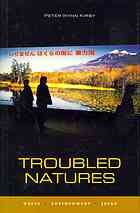Kirby, Peter Wynn. Troubled Natures: Waste, Environment, Japan. Honolulu: University of Hawaiʻi Press, 2011.
Troubled Natures by Peter Wynn Kirby  illustrates culturally specific understandings of waste in Japan gleaned through anthropological analysis. Blurring the distinction between the “human” and the “environment” while expanding the definition of “nature” in present day Japan, three chapters are of note for those interested in the social dimensions of environmental destruction. Chapter 4, “The Cult(ures) of Japanese Nature,” introduces Japanese conceptions of nature and the role of the environment in Japanese national identity. Chapter 6, “Pure Obsession,” describes how Japanese conceptions of purified space and the handling of waste manifests in the practices of social exclusion. In Chapter 7, “Growth, Sex, Fertility, and Decline,” Kirby argues that environmental toxins play a forceful role in population decline and flagging national morale. While not specifically dealing with nuclear waste, these three chapters nonetheless contribute to our understanding of the formation of contemporary Japanese perceptions of the environment that are invaluable to contextualizing the events of March 11th, 2011.
illustrates culturally specific understandings of waste in Japan gleaned through anthropological analysis. Blurring the distinction between the “human” and the “environment” while expanding the definition of “nature” in present day Japan, three chapters are of note for those interested in the social dimensions of environmental destruction. Chapter 4, “The Cult(ures) of Japanese Nature,” introduces Japanese conceptions of nature and the role of the environment in Japanese national identity. Chapter 6, “Pure Obsession,” describes how Japanese conceptions of purified space and the handling of waste manifests in the practices of social exclusion. In Chapter 7, “Growth, Sex, Fertility, and Decline,” Kirby argues that environmental toxins play a forceful role in population decline and flagging national morale. While not specifically dealing with nuclear waste, these three chapters nonetheless contribute to our understanding of the formation of contemporary Japanese perceptions of the environment that are invaluable to contextualizing the events of March 11th, 2011.
Kirby suggests that Japanese engagement with nature is one that is highly abstracted and removed from the materiality of nature itself, which may shed light on why much of Japan’s environmental destruction goes uncontested except in local contexts. In his fourth chapter, the incongruities between the Japanese self-professed love of nature and the concrete urban environment that characterizes the lives of three quarters of the Japanese population are contextualized within the genre of nihonjinron, or “discourses on the Japanese.” Kirby argues that nature in the lives of most ordinary Japanese is a largely mediated phenomenon, and is consumed in highly curated forms such as sculptured gardens and bonsai trees. The nationwide fixation on the efflorescent bloom of cherry blossoms in the spring, or the peak of fall foliage in “leaf-hunting” season, further belies the fetishization of nature as a fleeting phenomenon, according to the author.
Emphasizing a culturally situated understanding of “nature,” Kirby’s discussion of the Japanese myth of an intrinsic predilection toward nature provides a context for understanding how the cultural demarcation between “nature” and the “unnatural” (waste and other forms of pollution) plays a role in the broader context of social exclusion in Japanese society. Detailed in the chapter entitled “Pure Obsession,” Kirby asserts that dirt is in the eye of the beholder and describes the rituals of purification in contemporary Japan as performances that reify social identity and order. The sanitization of everyday life from exposure to the foreign may manifest itself in domestic spaces, such as the demarcation of the home as a safe space that must duly be kept free of germs, or in more insidious forms such as widespread social discrimination, wherein entire social groups are marked as a form of “social pollution.” The author explains that groups such as the historically excluded burakumin untouchables and other low-status workers are actively involved in the waste industry, thereby allowing the space of mainstream Japanese society to be preserved as “pure.”
Kirby situates toxic waste within the contemporary discourse of social malaise and population decline in “Growth, Sex, Fertility, and Decline.” Relating economic stagnation with toxic waste, infertility, and flagging morale, Kirby describes the perception among the Japanese that the endocrine-disrupting “environmental hormones” circulating in the air are related to the apparently shrinking genital sizes of recent Japanese babies. In addition to the problems of economic stagnation, the author explores the consequences of the post-war, government sponsored, high growth regime that built “Japan Inc.” and how the reciprocal obligations between state and industry led to gross oversights in safety regulations that facilitated the environmental pollution that now threaten Japan’s ability to product a vibrant new generation of people in the not-too-distant future.
Troubled Natures‘ discussion of waste and the environment raises some important insights and questions that may be useful to scholars and teachers interested in the social dimensions of the 3.11 disasters. Some example discussion questions related to this text may include the following: How does the handling of nuclear waste contribute to the politics of exclusion in Japanese society? How does the nature of radioactive particles disturb the notion that spaces – such as the home – can be actively defended against foreign agents? How would the people affected by the triple disasters be re-integrated in Japanese society, given the emphasis on contamination and social pollution?
–Shoan Yin Cheung
![[Teach311 + COVID-19] Collective](https://blogs.ntu.edu.sg/teach311/files/2020/04/Banner.jpg)